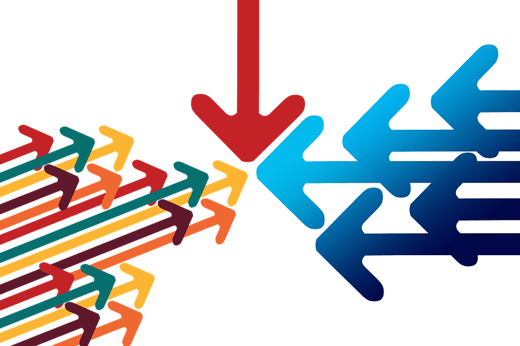Your organization’s culture is arguably your greatest strategic asset. Your competitors can potentially match your product or service by creating a marketing strategy as equally as powerful as yours. But, no other organization has your culture. It’s what makes you successful in what you do. So, what happens when your culture and another organization’s culture are supposed to merge into one? 
While Mergers and Acquisitions (M&A’s) are quite often positioned as a marriage, there is rarely love involved. There are always two sets of expectations trying to occupy the same space. Each side comes to the table with very different preferred outcomes. As Don Harrison, developer of the AIM methodology likes to say, “Same bed, different dreams.”
M&A is Culture Change: Prepare for It
Ironically, the more closely related the two businesses are, the more difficult the integration will be. In fact, the success rate of all Mergers and Acquisitions is only about 1 in 7. Why do so many deals fail? The number one reason is culture clash.
Your corporate culture is the collective pattern of values, behaviors, and unwritten rules of your organization—it’s the collective frame of reference for your organization. There are two sides of the iceberg we’ll call your organization, the formal and informal. The formal side is above the water line and includes:
- Policies and procedures
- Pay and compensation
- Job descriptions
- Organization charts

- Annual performance appraisals
The Informal side is what lays below the water line. It includes:
- Political systems
- Cultural norms
- Unwritten rules
- Relationships
- Informal leaders
- Informal and daily reinforcement management
During an M&A, millions of dollars will be spent trying to integrate the formal systems. Examples include; Human Resources policies, IT systems, org charts, etc. But the real work of an integration needs to occur below the water line where the informal culture of both the organizations lies.
Changing culture requires a whole lot more than putting out a new slogan and creating a new vision and mission statement. A series of workshops that describe the new culture, or communications from the top about what you want the new culture to be are just not going to cut it.
The Keys to Successful Integration
A successful M&A will take at least 18 to 24 months of extremely difficult work. It is a second order, transformational change that requires a structured implementation approach that addresses the human elements of the integration.
Here are a few of the keys needed to make a Merger/Acquisition successful based on the principles of the Accelerating Implementation Methodology (AIM):
- Define the Changes in Terms of Human Behavior - The speed of an integration is determined by how you manage the human elements of the change. Remember to define the changes in terms of what people need to be doing differently. What we are doing? Why are we doing it, and what are the consequences if we don’t succeed?
- Generate Sponsorship – Sponsorship is the single most important factor in ensuring a fast and successful implementation. Every Sponsor, from senior management down to the line managers, must express, model and reinforce their commitment to the change. You will not get a cultural change with minor changes in Sponsor behavior!
- Manage Resistance: Resistance is inevitable even when people see the Merger as positive. Resistance is a function of disruption and M&A can be very disruptive. Make sure you have a plan on how to manage it including responding quickly to concerns, rumors and questions.
- Tighten Up Communications: Every communication sent must include a feedback loop. This way, when a communication goes out, feedback will come back in. Use a variety of communication channels, with an emphasis on the face-to-face.
- Manage Reinforcements: The only way to implement actual culture change is to integrate the behavioral elements of the new culture into the daily business activities, and then, by dramatically changing the reinforcements—that is, the positive and negative consequences that managers apply on a daily basis with their direct reports.
Successful integration requires much more than the integration of policies, systems, and structures. Mergers and Acquisitions must be managed on both the technical and human sides, with necessary governance, with rigor and discipline. A solid strategy for integration that includes specific plans for building Sponsorship, Reinforcement, Cultural Fit and Communication is crucial. Remember, HOW you integrate teaches both organizations powerful lessons that remain long after the deal is signed!



